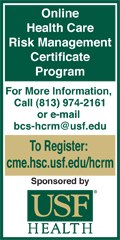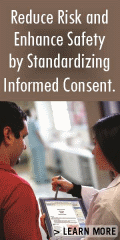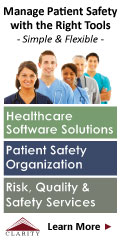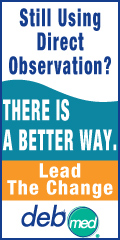 |
 |
 |

July / August 2005

Zero Errors
Aiming for Zero Errors
Clarian's Safe Passage Program
Improves Infusion Safety
By Dawn Daniels, DNS, RN, CCRN

Kathryn Rapala, JD, RN
Few issues command as much attention in the healthcare industry as patient safety. As healthcare professionals and hospital administrators know, nurses are key players in patient safety programs. Nurses are at the best vantage point to see, report, and fix errors before they occur, and the high-touch nature of their jobs puts nurses in the best seat to advocate for a patient and address looming safety issues.
Hospitals across the country are recognizing nurses' critical role in patient safety, and as a result, more nurses are being placed in pivotal care roles. Clarian Health Partners, a hospital system based in downtown Indianapolis, is doing just that.
Clarian implemented an award-winning patient safety program in 2001 called Safe Passage. The purpose of the program is to assure that a patient has a safe hospital stay or receives "safe passage" through the healthcare system. The program identifies a Safe Passage clinician for every unit. That clinician trains, supervises, and evaluates the unit and points out areas for safety improvements. Nursing, patient care services, and risk management staff all collaborate to make the program a success.
The program has implemented innovative communication and care strategies. Clarian formed a Safe Passage Council with several sub-councils organized according to hospital and care area. The sub-councils — composed of nurses, pharmacists, and other practitioners — meet monthly to discuss safety issues. The council structure is a valuable tool for the hospital system. Staff, who interface with patients on a daily basis, recommend safety changes to administrators. Administrators are pleased with the partnership, as their distance from day-to-day care sometimes puts them at a decision-making disadvantage. Additionally, due to the Safe Passage infrastructure, communication regarding patient safety issues is quicker and reaches front line staff.
The Safe Passage program has a system to assess near-miss events. The program also empowers staff at the front lines of patient care. Nurses and other practitioners are encouraged to mention clinical concerns to physicians. And before policies and procedures are mandated, patient care staff — who know most about work environment and care issues — are consulted.
Clarian has seen specific improvements as a result of the Safe Passage program. For example, occurrence reporting has increased 134%. And because of Safe Passage, Clarian hospitals have staff that communicate better, make fewer errors, and actively participate in decision making.
But like other hospitals, Clarian recognizes that it can't rest on its laurels. Patient safety has improved, and errors are down. But one mistake is one too many. And errors, especially medication errors, still happen. In an effort to strengthen patient safety on all fronts, Clarian reached beyond its current initiatives to address medication errors where they often start: the infusion process. Using the innovative Safe Passage program in concert with technology, Clarian recently studied whether medication safety systems are effective in reducing mistakes.
Study results prompted policy and procedure changes at Clarian, where Safe Passage clinicians continue to monitor IV infusion practices in an effort to make hospital stays even safer for patients.
Background on Medication Errors and Adverse Drug Events
Medication errors are common in hospitals, and adverse drug events (ADEs) often occur as a result. Patients in critical care areas are particularly susceptible to ADEs due to the higher percentage of intravenously administered drugs per patient (Cullen, et al., 1997). Pediatric patients, especially neonates, are also susceptible to ADEs due to their small size and higher potential for dosage error (Ross, Wallace, & Patton, 2000; Kaushal, et al., 2001).
Just how common are adverse drug events? Published reports by Bates, et al. (1995) suggest a rate of 6.5 ADEs for every 100 admissions. Reports also suggest 28% of those incidents are preventable.
Errors can occur at several points in the medication process. Medication administration by nursing has been shown to be the second most common incident (38%) associated with ADEs (Cullen, et al., 1997).
The most common proximal causes of ADEs during the nursing administration stage are inadequate drug knowledge and difficulties related to programming infusion pumps (Leape, et al., 1995). It has been estimated that infusion devices alone are responsible for 15% of fatal or life-threatening ICU iatrogenic complications (Giraud, et al., 1993). While hospitals are using more effective strategies to reduce ordering stage errors in ICU settings, similar efforts to reduce point of care medication administration errors are necessary.
The Quality Improvement Study
Intravenous medication administration errors can cause serious problems for a patient. Because they're a common cause of ADEs, hospitals must find a way to address them.
Clarian implemented the use of "smart" infusion safety technology in its three hospitals between 2001 and 2003. The hospitals used specially controlled intravenous infusion pumps with built in medication safety software in order to decrease errors at the point of administration and determine the incidence of IV infusion errors and near-miss events. Information obtained from this study has given Clarian the data to develop future quality improvement interventions aimed at decreasing ADEs and identifying potential ADEs before they occur.
The objectives of this study were to:
- Assess reported error rates for continuous intravenous medication infusion rates prior to and after the implementation of the medication safety system.

- Calculate rates for near misses.

- Identify trends present in ADEs by type of patient, type of drug or temporal factors such as time of day, shift, or weekend vs. weekday.

- Assess appropriateness of current drug library settings and hospital policy by identifying trends of overrides by type of patient and drug type.
Medication Safety System
The medication safety system contained a special software database known as a drug library, which was created and maintained by Clarian. The drug library was designed to assist healthcare professionals in administering IV medication by providing pre-set, "safe" parameters for infusions and by providing a guardrail against infusion device programming errors. The drug library feature also required healthcare professionals to confirm the patient care area, drug name, drug amount and diluent volume, patient weight, dose, and rate of infusion.
At Clarian hospitals, drug libraries were developed based on patient profile. Nine profiles were developed based on drugs, dosages and concentrations utilized in those areas. The profiles were adult critical care, pediatric critical care, pediatric medical-surgical, adult medical-surgical, pediatric anesthesia, neonatal critical care less than 2 kg, neonatal critical care greater than 2 kg, labor and delivery, and adult hematology-oncology. If a pre-set lower or upper limit was breached, then the caregiver was alerted. If the site had pre-set hard limits, then the infusion system would not deliver the medication at a rate programmed above or below that limit.
In January 2003, a software upgrade expanded the variety of medications in the drug library. The upgrade also allowed Clarian to download detailed aggregate data about near misses — overrides and alerts that resulted in reprogramming. The data included date, time, patient profile, drug, programmed dose, and amount the dosage exceeded limits. This information was important for quality improvement. It allowed Clarian to analyze the appropriateness of the clinical practice and to identify potential areas for future interventions.
Methodology
This study utilized a retrospective descriptive design. The study was conducted at Clarian's three major hospitals: Methodist Hospital, Indiana University Hospital, and Riley Hospital for Children. The study was approved by the Institutional Review Board of Indiana University/Clarian Health Partners.
All Clarian patients who received continuous IV medications while being treated from February 1, 2001, to July 31, 2001, and from February 1, 2003, to July 31, 2003, were included in the study. Patients who did not receive continuous IV medications were excluded. A total of 1,915 point-of-care units were downloaded for quality improvement purposes.
A total of 39,424 software-triggered safety alerts occurred at Clarian hospitals during the study period. Of those events, 18,583 occurred on pumps at Methodist Hospital, 15,086 were on pumps at Indiana University Hospital, and 5,755 were on pumps at Riley Hospital for Children.
The largest number of alerts (n=22,031; 55.9%) occurred in the adult ICU profile. This is not surprising because the majority of nurses used the drug library care for adult critical care patients. The adult medical-surgical profile had the second highest number of events (n=5,419; 13.7%).
Not surprising, the adult ICU profile had the highest number of events that could be indicative of a potential ADE (i.e., the alert resulted in reprogramming, canceled infusion, or drug selection canceled.) The adult ICU had 1,138 such events followed by adult medical-surgical with 290 events, PICU with 208 events, and general pediatrics with 123 events.
The largest percentage (n=22590, 57.3%) of alerts was for dose above maximum, while the second largest number of events (19.0%, n=7478) was for secondary stops.
Of the software-triggered safety alerts occurring at Clarian during the study period, 13,343 (33.8%) were considered to be valid events, i.e. they were for such things as secondary stops. That left a total of 26,081 events that were considered to be potential errors by the drug library memory. Of those "potential error" events, in 24,110 instances (92.4%), the action proceeded without any changes. In 204 instances, the infusion was canceled, while in 19 instances the drug selection was canceled. However, in 1,748 instances, the pump was reprogrammed. This resulted in a total of 1,971 potential ADEs that were averted because of the safety software.
For Clarian, the percentage of software-triggered alerts by day of the week ranged from a low of 11.3% (n=4,441) on Sundays to a high of 18% (n=6,041) on Fridays. While the percentages varied at the individual hospitals, the same trends were present.
A total of 448 of the events occurring on Fridays resulted in an action indicative of a potential ADE that was prevented by the medication safety system (i.e. the resulting action was reprogramming, a canceled infusion or a drug selection cancellation.) While the lowest percentage of total events occurred on Sundays, the lowest number of events indicative of a potential ADE occurred on Tuesdays.
The largest number of software-triggered alerts occurred in January (4,459; 11.3%), followed closely by February (4,450; 11.2%.) The largest number of events resulting in reprogramming occurred in February for the Clarian system (n=195). When examining reprogramming by individual hospitals, this same pattern held true for Methodist Hospital. At Riley Hospital, the highest reprogramming occurred in February and July. However, at Indiana University Hospital, the highest reprogramming occurred in June.
The largest number of software-triggered alerts occurred between 8 a.m. and 3 p.m. with the periods of 10 a.m. to 11 a.m. and 1 p.m. to 2 p.m. being the highest, each accounting for 6.1% of events. These were also the times of the day when the largest number of pumps had an alert that resulted in reprogramming. There is some slight variation when examining the individual hospitals, as Methodist had the highest amount of reprogramming between 2 p.m. to and 3 p.m.
Select Drugs and Software-Triggered Safety Alerts
Propofol (n=6,192) was the drug most associated with software-triggered alerts. The largest percentage of alerts (n=5,988; 96.7%) was due to dose above maximum limit. The pump was reprogrammed in 227 of these instances. It is suspected that a large number of these alerts were due to drug bolusing. In 790 instances, alerts occurred for "dose below minimum" for dopamine, dobutamine, norepinephrine and epinephrine. However, the drug rates were reprogrammed in only 28 of these instances.
After reviewing these numbers, Clarian reconsidered the drug minimum setting in the library for these drugs, especially since these drugs are easily titrated to effect based on patients' blood pressure or heart rate. Patients on these drugs are on continuous monitoring for these parameters. If a dose below minimum occurs in error, it will be caught quickly since, when adding these drugs or changing these rates, the nurse remains at the bedside to evaluate these effects until the parameters have stabilized. The elimination of "nuisance" alarms will prevent the nurse from becoming desensitized to unnecessary alarms.
The infusion of heparin (non-ECMO) initiated alerts 1,286 times. A total of 261 of those events could be considered potential ADEs. This included 138 instances in which the pump was reprogrammed because the dose was above the maximum limit; 57 instances in which the pump was reprogrammed for a dose below the minimum limit; 53 instances in which the selection was canceled; and 13 instances in which the dose was canceled because the same drug was infusing on another channel.
There were 1,095 heparin alerts for "dose above maximum." Of these events, 138 had to be reprogrammed. Of the reprogrammed events, 18 heparin doses were in error by a factor of 10 times the appropriate amount, and 22 doses were in error by a factor of 100 times the appropriate amount.
There were 125 heparin alerts that were for "dose below minimum." Of these events, 57 had to be reprogrammed. Of the reprogrammed events, 3 heparin doses were in error by a factor of 10 times below the appropriate amount, and 42 doses were in error by a factor of 100 times below the appropriate amount.
The infusion of insulin (insulin and regular insulin combined) initiated alerts 1,180 times. A total of 127 events could be considered potential ADEs. This includes 72 instances in which the pump was reprogrammed because the dose was above the maximum limit; 19 instances in which the pump was reprogrammed for a dose below the minimum limit; 26 instances in which the selection was canceled; and 10 instances in which the dose was canceled because the same drug was infusing on another channel.
There were 786 insulin alerts that were for "dose above maximum." Of these events, 72 had to be reprogrammed. Of the reprogrammed events, two insulin doses were in error by a factor of 10 times the appropriate amount, and one dose was in error by a factor of 100 times the appropriate amount.
There were 358 insulin alerts for "dose below minimum." Of these events, 19 had to be reprogrammed. Of the reprogrammed events, one insulin dose was in error by a factor of 10 times below the appropriate amount.
Understanding the Data Through
Focus Groups
Under the Safe Passage process, it is important to understand the data in the context of work. Decisions made in regard to practice based on data alone do not take into account work complexity, communication, culture, process and other factors necessary for the success of an initiative. To address the gap between data and practice, focus groups were held to determine practice around the data.
Heparin and insulin were the subject of the focus reviews. Potential ADEs when using these drugs are cause for concern for several reasons. Unlike vasopressors, in which a miscalculation of a rate is usually visible quickly because of the effect on vital signs, a miscalculation of a heparin rate may go undetected until the bloodwork is drawn and comes back from the lab, or the patient becomes symptomatic. By this time, there may be serious patient complications — either bleeding because of a dose above maximum, or an infarct because of non-therapeutic dosing. The rate of heparin is frequently low and often involves a decimal point, which is easy to put in the wrong place when programming the pump.
The ease with which dosage errors could be made, combined with the delay in catching rate errors and the high patient risk associated with adverse drug effects emphasizes the importance of using safety software when infusing heparin. Although the safety alert for heparin is present on many of the profiles, the software's drug library is not always initiated when heparin is infused.
Similarly, a miscalculation of an insulin rate may go undetected until a blood glucose level is checked or symptoms appear. By this time, there may be serious patient complications because of hypoglycemia. If the error is for a low dose, the patient may sustain increased damage from hyperglycemia. Like the rate of heparin, the rate of insulin is frequently low and often involves a decimal point, which is easy to put in the wrong place when programming the pump.
Focus group participants included Safe Passage members, front line staff, managers, and pharmacists. Focus group requirements included an open and honest discussion, a comfortable and safe environment, and current practice whether "right" or "wrong," including common and uncommon practices. Using this technique, the organization can get a good picture of clinical practice in a short time.
Participants were asked for decision points in the administration of heparin and insulin. Staff identified patient status, equipment availability, physician knowledge, other fluids hanging, the physician, syringe size, labs, access, and a myriad of other considerations made when hanging and maintaining drips. Technology reveals some of this work complexity. Staff noted, for example, that the safety software frequently triggered alerts between 11 a.m. and 2 p.m., which were "lunch hours" for most units when nurses cover for each other's patients.
The focus group also identified barriers to use of the medication safety system. Among them: the smart pump takes more time in emergencies, staff are creatures of habit, and staff unawareness of/lack of trust in the software. The group also noted that smart pumps often eliminate barriers and provide a "double check" of practice.
Using information from the focus groups, Clarian has provided important feedback to the pump manufacturer and reconciled data with daily practice to make improvements throughout the hospital system.
Limitations of Data and Other Discussion
Some limitations decrease the usefulness of this data from a quality improvement status and a research perspective. These limitations include:
- Determining which event codes were associated with which hospital. Because the pumps traveled between units and between hospitals, the data for Riley Hospital could potentially include events that occurred at Indiana University or Methodist Hospital. This limited the usability of such data for the association of events with time of day, month and patient profile. It was also difficult to link data with the written occurrence reports and patient acuity. Because of this, it was hard to determine if one unique issue skewed the data or if there were systematic issues (including staffing patterns, educational issues and physician issues) that need to be investigated further.
This is not as serious an issue for a single hospital where the pumps stay in one facility, although since pumps typically travel with patients between units, it will be difficult to determine if there are specific units where issues occur. If possible, pumps should stay within a single facility when used in a multi-facility system.

- Inability of this study to determine the usage of software-triggered safety alerts in general as well as the selection of the appropriate patient type. It is unknown how often the drug library and software-triggered safety alerts are utilized (i.e. what percentage of the time are fentanyl drips infused on either syringe pumps or on the smart pumps without using the safety alert feature.) Also unknown is how patient profile is chosen — by physical location of the patient or by diagnosis? A method for validating both patient profile and utilization of the safety software is needed when future research is conducted. It is also needed to validate future quality improvement projects. The utilization of software-triggered safety alerts would be a useful performance improvement project; the choice of software-triggered safety alerts could be an interesting qualitative study.
Summary
Many errors occur in healthcare, and many are addressed through voluntary reporting and resulting performance improvement activities. The smart pump detects and addresses silent errors at the point of contact and provides insight as to practice complexities and gaps in the work environment. It is important to couple innovative patient technology and information with a culture that understands the work environment, and base resulting improvements on an understanding of the work environment.
The use of infusion safety technology helps prevent serious patient complications. It's also a good example of how technology helps healthcare systems achieve high reliability. Through use of this technology, Clarian has been able to standardize practice, while reducing variability, and improve outcomes for both staff and patients.
Dawn Daniels (dmdaniels@clarian.org) is program coordinator for the Injury Free Coalition for Kids of Indianapolis and a pediatric trauma researcher at Clarian Health Partners. She also serves as a clinical instructor at Indiana University. Since beginning her nursing career in 1983, Daniels has worked with pediatric patients in the Midwest and in Florida. At Clarian, her work includes committee membership and leadership on policies, procedures, regulatory compliance, injury prevention, quality improvement, and Magnet designation efforts across the hospital system. A graduate of Pensacola Christian College, Daniels received her master's and doctoral degrees from Indiana University.
Kathryn Rapala (krapala@clarian.org) is the director of risk management and patient safety at Clarian Health Partners. Prior to this role, she served in risk management, quality improvement, and staff nursing positions at Clarian hospitals in downtown Indianapolis. Rapala was a Fellow in the National Patient Safety Foundation Leadership Fellowship in 2002-2003; and she was the first-ever recipient of the Todd Pickett National Patient Safety Award from the American Society for Healthcare Risk Management in 2004 for her role in establishing the Safe Passage Program at Clarian.
References
Bates, D. W., Cullen, D., Laird, N., et al. (1995). Incidence of adverse drug events and potential adverse drug events: Implications for prevention. Journal of the American Medical Association 274, 29-34
Bates, D. W., Leape, L. L., Cullen, D. J., et al. (1998). Effect of computerized physician order entry and a team intervention on prevention of serious medication errors. Journal of the American Medical Association 280, 1311-1316.
Bates, D. W., Teich, J., Lee, J., et al. (1999). The impact of computerized physician order entry on medication error prevention. Journal of American Medical Informatics Association 6, 313-321.
Cullen, D. F., Sweitzer, B. J., Bates, D. W., Burdick, E., Edmondson, A., Leape, L. L. (1997). Preventable adverse drug events in hospitalized patients: A comparative study of intensive care units and general care units. Critical Care Medicine 25, 1289-1297.
Giraud, T., Dhainaut, J. G., Vaxelaire, J. F., et al. (1993). Iatrogenic complications in adult intensive care units: a prospective two-center study. Critical Care Medicine 21, 40-51.
Kaushal, R., Bates, D. W., Landrigan, C., McKenna, K. J., Clapp, M. D., Federico, F., Goldmann, D. A. (2001). Medication errors and adverse drug events in pediatric inpatients. Journal of the American Medical Association 285(16), 2114-2120.
Leape, L. L., Bates, D. W., Cullen, D. J., et al. (1995). Systems analysis of adverse drug events. Journal of the American Medical Association 227, 307-311.
Leape, L. L., Cullen, D. F., Clapp, M. D., et al. (1999). Pharmacist participation on physician rounds and adverse drug events in the intensive care unit. Journal of the American Medical Association 282, 267-270.
Ross, L. M., Wallace, J., Paton, J. Y. (2000). Medication errors in a paediatric teaching hospital in the UK: Five years operational experience. Archives of Diseases of Children 83, 492-497.
|
 |
 |
 |


















|
 |



